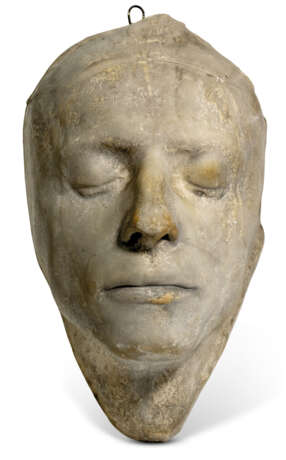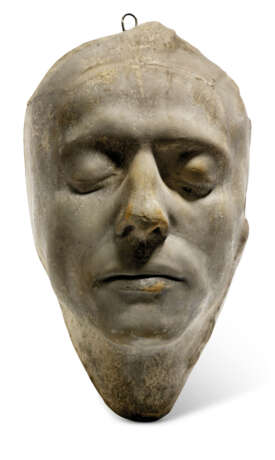ID 470112
Lot 46 | John Keats (1795-1821)
Estimate value
£ 12 000 – 16 000
Death mask. c.1898-1905
KEATS, John (1795-1821) – DEATH MASK. Plaster cast with light brown patina, inscribed ‘C. Smith London No 231’ at crown and ‘Keats’ at throat, hanging hook at back. Approximately 275 x 160 x 155mm., pale grey paint applied over shellac base as common (paint a little rubbed.) [London: Charles Smith, c.1898-1905].
A rare cast of John Keats, capturing a true likeness of the poet at the height of his powers and memorialising him for posterity. John Keats died of tuberculosis in Rome during the night of 23 February 1821, attended only by his friend, the artist Joseph Severn. The death mask was taken the next day, when ‘a gentleman was sent to cast the face, hand and foot’. Severn used these casts for his posthumous full-length portrait of Keats (now in the National Portrait Gallery; see also Lot 47), which he undertook in an attempt to exorcize ‘the impression [of Keats's death which] was so painfull on my mind’ and to memorialize his friend with ‘the most pleasant remembrance.’ Severn had begun the portrait by 16 May 1821, when John Taylor, Keats's publisher, wrote to him requesting that he send Taylor the casts. Severn replied that ‘the casts I must send another time because I still require them to finish the picture from.’ The portrait, finished about 1822, is thus in part a contemporary depiction of the death mask; it is among the most enduring images of Keats.
A careful study of the death mask by Peter Malone has critically reassessed earlier accounts of its history. In sum, he has established that the identity of the castmaker is unknown and that the surviving casts come from two separate sources. The best were produced in London by Charles Smith around 1898-1905 and are inscribed with Smith’s name at the crown with his inventory number 231 and the poet’s name at the throat. In addition to the Smith casts is one made, still today, by the Lorenzi castmakers at Paris, where it is no. 921 in their catalogue, lacking the Keats name and misidentified as Baudelaire. Malone has found casts from this mould also misidentified as Napoleon I and the astronomer Le Verrier.
The present example is a hitherto unknown copy of a Smith cast, joining 8 other known examples:
1) London, Metropolitan Archives, J.H. Preston copy.
2) London, Metropolitan Archives, a copy taken in the 1980s from a damaged mask found (and now lost) at the V.
3) Rome, Keats Shelley Museum, Rome, given by Dr. Bradley.
4) London, Hampstead, Keats House Museum, Hampstead, given by Molly Hardwick.
5) Eton, Meynell copy, bought at Sotheby’s, 1986.
6) USA, private collection, bought at Christie’s, 1996.
7) Private collection, bought at Sotheby’s, 2018.
8) Private collection, a copy without ‘Keats’ inscribed, surfaced in the US in 2019.
Note: Severn did later send the death mask to John Taylor and they were sold at Taylor’s death to Richard Monkton Milnes, Lord Houghton (sale Christie’s, 17 March 1865, lot 29); that cast is now lost.
Cf. Peter Malone, ‘Keats’s “Posthumous Existence” in Plaster’, The Keats-Shelley Review, vol. 26, 2012, 125-35.
| Place of origin: | Northern Europe |
|---|
| Place of origin: | Northern Europe |
|---|
| Address of auction |
CHRISTIE'S 8 King Street, St. James's SW1Y 6QT London United Kingdom | |
|---|---|---|
| Preview |
| |
| Phone | +44 (0)20 7839 9060 | |
| Buyer Premium | see on Website | |
| Conditions of purchase | Conditions of purchase |





